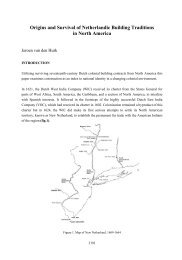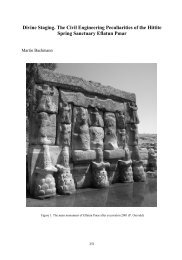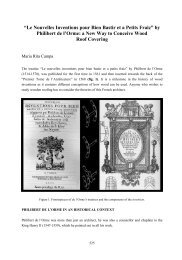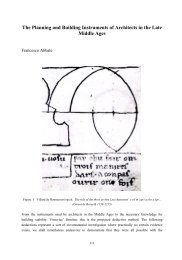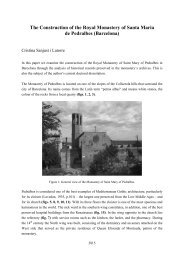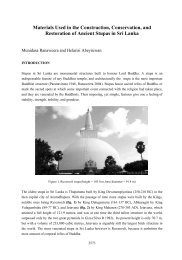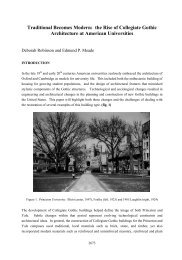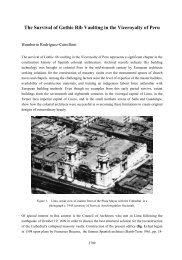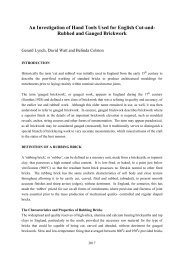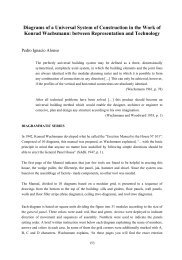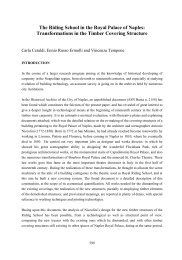bricks from the - Department of Architecture
bricks from the - Department of Architecture
bricks from the - Department of Architecture
Create successful ePaper yourself
Turn your PDF publications into a flip-book with our unique Google optimized e-Paper software.
8<br />
Dr Stern <strong>the</strong>n briefly describes his own experiments using two<br />
sets <strong>of</strong> paste made up <strong>of</strong> clay and equal amounts <strong>of</strong> liquid. In one<br />
case tap water was usedi in <strong>the</strong> o<strong>the</strong>r, an aqueous extract <strong>from</strong> straw<br />
was used. Dr Stern is fully aware that 'clay <strong>of</strong> <strong>the</strong> kind used by<br />
sculptors is not <strong>the</strong> same as <strong>the</strong> mud <strong>of</strong> <strong>the</strong> Nile, and English straw<br />
may not be <strong>the</strong> same as that <strong>of</strong> Egypt, I but his results were none<strong>the</strong>less<br />
interesting. Using a Rotovisco viscometer he measured <strong>the</strong> viscosity<br />
<strong>of</strong> <strong>the</strong> two sampIes at different rates <strong>of</strong> shear. In all cases,<br />
but particularly at low rates <strong>of</strong> shear, '<strong>the</strong>viscosity <strong>of</strong> <strong>the</strong> paste<br />
made with <strong>the</strong> straw extract was greaterby some 50 per cent than when<br />
water alone was used'. As Dr Stern observes, this would result in 'a<br />
more solid brick, less liable to be deformed during handling and<br />
drying' .<br />
This is an interesting comment on <strong>the</strong> use <strong>of</strong> straw by <strong>the</strong> Hebrew<br />
slaves, and members interested in this period <strong>of</strong> <strong>the</strong> history <strong>of</strong><br />
brickmaking are urged to read Dr Stern's.article in full.<br />
(TPS)<br />
Notes and References<br />
1. H.Stern, -'Bricks without Straw', Jewish Chronicle, 5945, 18 Nisan<br />
5743/ 1 April 1983, 15.<br />
2. The Haggadah (Heb. 'narration') is <strong>the</strong> service book used during<br />
<strong>the</strong> Seder service/meal on <strong>the</strong> first night <strong>of</strong> Pesach/Passover in<br />
<strong>the</strong> Jewish faith. Numerous modern editio~s, with English translation,<br />
are easily available. Amongst o<strong>the</strong>r things it includes<br />
an account <strong>of</strong> <strong>the</strong> slavery in Egypt. The Seder itself involves a<br />
number <strong>of</strong> symbolic foods, including haroset, a (basically) nut<br />
and apple paste intended to resemble.<strong>the</strong> material <strong>from</strong> which <strong>the</strong><br />
<strong>bricks</strong> were made. (Ed.)<br />
3. The <strong>bricks</strong>, <strong>of</strong> course, were sun-dried, not burned. (Ed.)<br />
ANGLESEY AND CLAY: Part 11<br />
Bri-gadier Arthur<br />
Trevor<br />
1. Anglesey Kiln-Tiles. As a result <strong>of</strong> visiting old windmill and<br />
watermill sites, fragments <strong>of</strong> various types<br />
<strong>of</strong> kiln-tile have come to light: at present about twelve patterns<br />
have been found. Two sources have been definitelyidentified <strong>from</strong><br />
impressed marks on fragments: (1) Sealy & Sons, Bridgwater, Somerset,<br />
and (2) Ewloe Firebrick Co., Buckley, Flintshire (Clwyd). A third<br />
impressed mark has been tentativel~ id~ntified asCa<strong>the</strong>rall, also <strong>of</strong><br />
Buckley. The kilns (Welsh 'crasdy')were primarily for corn-drying,<br />
but were possibly also used in <strong>the</strong> production <strong>of</strong> malt." All <strong>the</strong><br />
recently found tiles have square 'honey-combing' on <strong>the</strong> lower face,<br />
and <strong>the</strong> norm appears to have been ei<strong>the</strong>r five or nine perforations<br />
per 'celI' in <strong>the</strong> 'honey-comb'. One very primitive specimen, <strong>from</strong> a



